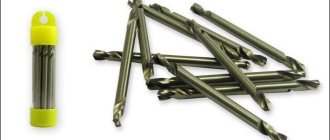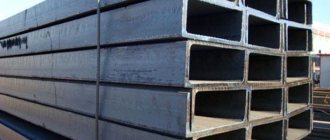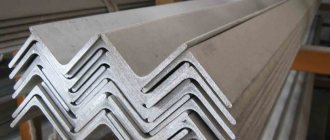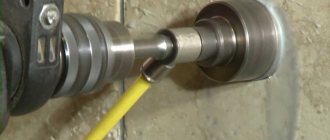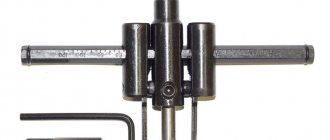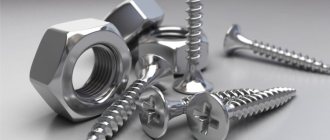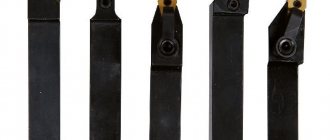When choosing equipment for drilling holes, you need to take into account its technical characteristics. Particular attention should be paid to the diameter of the metal drill. The purpose, cost of the gimlet, and its cost depend on this indicator. The characteristics of drills are determined by state standards that manufacturers must comply with.
Drill bits
Purpose
Metal drills are used to perform various jobs:
- drilling holes of different diameters and depths;
- creating smooth blind recesses in metal blanks;
- removing debris from broken equipment;
- for thread cutting.
There are drills for drills, screwdrivers, and industrial equipment.
Design features
A drill is an axial cutting tool. For drills and screwdrivers, cylindrical rods with spiral sharpening are used. Drills consist of several parts:
- shank;
- necks;
- working part.
The cutters are fixed on the working part. The cutting part consists of two elements - two sharp incisors and auxiliary cutting edges.
Drill design (Photo: Instagram / 73instrument)
On what basis should you choose a drill?
When choosing a drill, focus on the following indicators:
Weight - a quality drill should not be light; Experts recommend buying cutting tools weighing 14 grams or more. If the store doesn’t have scales, rely on your feelings.
Strength - for a metal product to yield to a drill, it must be strong; You can check the strength using a glass bottle. Scratch something on the glass with the working surface of the tool - there should be impressive scratches on the bottle and glass chips around them.
Workmanship - craftsmen advise using drills made by milling followed by grinding.
Sharpening angle - for metal it is better to choose drills sharpened at an angle of 130-135 degrees.
Steel grade - buy tools that will fit your equipment (drill, drill press, etc.).
Classification
You can find different types of drills on sale. They are classified depending on color, material, type of shank, type of coating, and accuracy class.
By color
A faded yellow tint appears after a vacation at work. Thanks to additional processing, the durability and strength of the equipment increases.
The bright yellow equipment is durable and wear-resistant. It has a low friction index. The equipment has a titanium coating, which provides it with increased strength.
Black color indicates additional steam treatment. This is durable equipment with a long service life. The cost is not very high.
Drills of the lowest quality that have not been subjected to additional processing are gray in color. Such equipment has a low price, but you won’t be able to save money, since the drills break quickly.
By material
Drills are made from different types of steel:
- carbon tool;
- alloyed instrumental;
- high-speed
Additionally, plates made of hard alloys are attached to the cutting parts.
Steel drills (Photo: Instagram / linkorspb)
By shape
Kinds:
- Stepped, conical. They are also called gimlets. The working part has a conical shape. Designed for drilling holes of different diameters in metal sheets up to 2 mm thick.
- Centering. Multifunctional gimlets, which are needed for creating special holes in metal workpieces. The parts are fixed in drilling equipment.
- Elongated. Used to create blind, through holes.
- The first ones. Tool with replaceable inserts. With its help you can make large diameter holes with smooth walls.
- Crowned. Hollow crowns that have many sharp teeth along the edges. Suitable for drilling holes in thin metal sheets up to 30 mm in diameter.
- Threaded. Used for cutting threads in pre-prepared holes.
- Highly accurate. With their help, you can perform precise technological operations.
- Left-handed. Equipment for highly specialized purposes, which is needed for drilling damaged equipment out of holes.
The most common type of metal drills is twist drills. Designed for drilling holes of different depths and diameters.
Conical drills (Photo: Instagram / dismart_kh)
By shank type
Types of shanks:
- Conical. The equipment is designed for high-power, professional drills or industrial drilling machines.
- Cylindrical. Suitable for power tools.
- Hexagonal. Used for fastening in jaw chucks and clamps.
By type of coverage
The following can be applied to drills:
- titanium aluminum nitride;
- titanium carbonitride;
- diamond chips;
- titanium nitride ceramic coating;
- oxide film.
The last type of coating is the most affordable and reliable.
Cobalt drills (Photo: Instagram / vmiha80)
By accuracy class
Accuracy class:
- Normal accuracy marked B. Designed for drilling holes with an accuracy of up to 15 grade.
- Normal accuracy marked B Designed for drilling holes up to accuracy class 14.
- High precision equipment marked A1. Suitable for creating holes with accuracy from 10 to 13 classes.
Piece
matrix 72356 73
pros
- titanium coating
- hex shank
- low price
Minuses
- difficulty of sharpening
From 375 ₽
The step drill drills holes from 4 to 20 mm in sheet metal up to 0.5 cm thick. Consumers note its versatility, hole quality (ideal geometry, no chamfers), ease of use (no need to core or drill), durability (thanks to nitride coating titanium). Disadvantage: it is difficult to sharpen cutting edges yourself at home.
STAYER 29660-6-20-8 20 x 75 mm
pros
- 8 steps
- sharpening angle 135º
- drilling depth up to 0.6 cm
Minuses
- No
From 438 ₽
The product from a well-known German brand is designed for drilling in particularly hard, including stainless alloys up to 0.6 cm thick. Durable HSS alloy and a sharpening angle of 135º ensure long-term operation. It is necessary to strictly follow the application technique: drill strictly perpendicular to the surface, use oil to reduce friction, select a speed of no more than 1000 rpm.
FIT 36395 20 mm
pros
- 9 steps
- high speed steel
- wear resistance
Minuses
- cylindrical shank
From 633 ₽
The model is designed to produce holes with a diameter of 4-20 mm in sheet metal up to 0.2 cm thick of fairly hard grades. The tool copes worse with high-alloy alloys - due to the cylindrical shank, it can slip in the drill chuck. With proper use it will last for more than one year.
GRAFF GMSD430
pros
- 14 steps
- triangular shank
- tip point
Minuses
- high price
From 1,414 RUR
The tool is made of high-speed steel grade R6M5. It drills holes of 14 diameters well in sheet carbide metal up to 0.2 cm thick, plastic, plexiglass, etc. The triangular shank prevents rotation in the chuck, ensuring the transmission of significant torque, which makes working with stainless steel and other types of alloy steel much easier. The downside is the high cost.
PRACTICE 774-474 12 mm
pros
- titanium nitride coating
- steel R6M5
- wear resistance
Minuses
- cylindrical shank
From 488 ₽
Step drill for producing holes from 4 to 12 mm in metal and plastic surfaces up to 0.2 cm thick. Titanium coating significantly extends the life of the tool. Oil or water cooling is recommended to prevent overheating.
Dimensions
The dimensions of metal drills are indicated in government documents, which manufacturers of certified products must follow. The requirements are regulated by GOST 886–77, GOST 4010-77, GOST 10902–77. Depending on the size, accessories for power tools are divided into 3 groups:
- Short - self-tapping screws with a length from 20 to 131 mm. Outer diameter - up to 20 mm.
- Extended - equipment up to 205 mm long. The diameter is similar to short drills.
- Long - length up to 254 mm. Outer diameter - up to 20 mm.
Sometimes you need to make a hole for the self-tapping screw before screwing it in. There is no point in selecting equipment of the same diameter as the fastening element, since the fastening will not hold. To select the diameter, it is recommended to use ready-made calculation tables.
Drills of different lengths (Photo: Instagram / promoborydivanie)
Marking
If you know how to understand the equipment markings, you can find out the technical characteristics and purpose of the drills. Designations:
- The alloy of the material, the amount of alloying additives is indicated in Latin letters with numbers. For example, K3, the alloy from which the drill is made, contains 3 parts of cobalt.
- High speed steel is designated by the letter P.
Foreign manufacturers use the HSS marking. It is applied to high quality equipment.
Visual identification of drill type
By the appearance of the cutting gimlet, you can determine the type of material from which the products are made and thereby find out the mechanical strength of the sample. By color you can determine the composition and quality of workmanship.
Grey
Gray drills are made of metal that has not been subjected to any additional processing.
The quality of the tool, in this case, leaves much to be desired, but for one-time use such products are quite suitable.
Black
This color indicates that the tool was treated with superheated steam. During processing, the product acquires greater strength.
It perfectly tolerates numerous cycles of heating and cooling of the metal, and also maintains the sharpening of the working surface for a long time.
The price of black metal drills is not much higher than gray products, so if you have a choice, you should give preference to tools of this type when purchasing.
Dark golden
This color indicates that the cutting tool has been tempered. This type of processing significantly increases the mechanical strength of the product as a result of reducing internal stresses.
With a tempered drill, you can successfully process high-strength metals, so if you are drilling too hard alloys, it is recommended to purchase a similar model.
Bright golden
The bright golden color indicates that metal made with the addition of titanium was used in production.
Despite the high cost of such models, it is much more practical to purchase a high-quality drill than to use cheap cutting tools, which will need to be used in large quantities for complex work.
Thus, it is easy to determine the quality of products by appearance and decide which metal drills are best to buy.
Selection principles
When choosing, you need to consider:
- product color;
- purpose of equipment;
- quality of sharpening;
- symmetry of incisors;
- equipment material, type of protective coating.
Drills of different types (Photo: Instagram / koleso_ast)
Advantages and disadvantages
Advantages:
- the ability to perform various technological operations;
- strength, reliability, durability;
- low price.
Only cheap gimlets have disadvantages, which are made from low-quality materials and do not have a protective coating.
Manufacturers and prices
Manufacturers:
- Bosch;
- Haisser;
- Ruko.
Gimlets with the USSR designation are considered the most reliable and durable. The price of a classic drill marked HSS is 500 rubles.
Bosch brand drill (Photo: Instagram / sergei.wood_man)
Which manufacturers can you trust?
The quality and service life of metal processing drills depends on the manufacturer. Craftsmen who use drills every day claim that good tools can be found both from domestic and foreign companies. Russian-made drills are wear-resistant, strong and durable, but, unfortunately, there are fewer and fewer of them on the market every year. Now products and “Zubr” are in demand. These brands produce inexpensive but reliable high-quality instruments. Drills and “ATTACK” have also proven themselves well. Among imported ones, professionals prefer metal cutting tools, Bosch, Haisser and Makita. Their characteristics are approximately the same: they can withstand extreme loads, work “for wear”, and wear occurs slowly. Good value for money. There are two more and Dewalt. Their products differ from others in their high drilling speed. The price of a tool depends on the country of manufacture, length, diameter, strength and what it is intended for.
| Rating of the best drills for metal processing |
| Bosch 2607017154 |
| Attack N802-6 |
| Wurth Zebra Spiralbohrersatz HSS |
| Anchor 25219 |
| Metabo Bestell-Nr. 27 094 HSS-G |
| AEG HSS-G 4932430416 |
| Bison MET-SH H19 R6M5 |
| DeWALT DT7926 Extreme2 HSS |
| Hawera HSS-C Spiral Bohrer GQ-32692 |
| Irwin TurboMax 10503992 |
Sharpening rules
To sharpen a drill yourself, you can use a sharpening machine, hand tools, or special mechanical sharpeners. It is important to take into account some features:
- During sharpening, the cutting edges should be positioned parallel to the abrasive surface of the whetstone.
- When sharpening a drill, do not press hard on it. This especially applies to sharpening equipment on sharpening machines.
- It is important to control the length of the cutting edges. They must be the same length.
Regrinding can be considered completed when the metal surfaces being processed stop reflecting.
What devices are used for sharpening drills?
You can sharpen a dull cutting tool on a special industrial machine. It can be professional or domestic. The first is used for mass sharpening of drills in enterprises or professional firms. The second one is convenient to use at home or in the garage. A metal drill can be sharpened with a highly specialized machine (only for one type of equipment) and a universal one, which is used to work with other types of drills. Depending on the type of work, sharpening tools can be electrical or mechanical. You can make a device for sharpening cutting tools yourself or purchase it in a special store. Professionals prefer to use such machines as “REZER”, as well as domestic devices, “Caliber”, “Kraton”.
Difference from wood drills
Gimlets for metal differ from equipment for drilling wood:
- The strength of the alloy. For the manufacture of metal drills, more wear-resistant material is used.
- Angle between incisors.
- Sharpening. Metal gimlets do not have a centering point.
It is difficult to choose equipment without practical skills or knowledge of theory. The choice is complicated by a large assortment of drills and differences in technical characteristics. It is enough to study the features of different types of equipment in theory in order to choose drills for power tools.
Metal drill bits from Aliexpress. Plasticine or not. A short review.
There is an opinion that Ali's drills are usually of poor quality. I myself hold a similar opinion. I reviewed various drill bits for tiles and glass, and they weren’t particularly impressive with the results when compared to even some Chinese brands from our stores. I decided to try to order a set of ten drills and compare them with those purchased offline. And I will compare them with drills with cobalt coating, because due to my own stupidity I was sure that I also ordered cobalt ones from Ali. Why did I actually cling to these drills and why did I not like the drills that you can buy from us, because they are inexpensive? The thing is that at work I periodically have to drill into safes to install sensors inside them. The safes are made of steel on the outside and concrete on the inside. Not in the sense that he opened the safe, but there is concrete inside. No, the inside is also covered with steel, and the walls of the safe are a kind of sandwich of metal and concrete. The metal is not very thick, just a few millimeters. And this thickness varies depending on the safe. And it’s this metal that you need to grab onto with fasteners. And when you drill it, the drill inevitably passes through the metal and meets the concrete. And the main thing is not to miss this moment, otherwise the drill will only be enough for one hole. But still, with this approach, the drills inevitably and quite quickly become dull. And then either sharpen it or throw it away. And in fact, it doesn’t matter whether this branded drill is expensive or some inexpensive option. Both will become dull, and quite quickly. Concrete doesn't care about the quality of your drill. And therefore there is no particular point in buying expensive drills. And since there is no point in buying expensive ones, then why not order cheap ones from Ali and try. If they can drill through metal acceptably, then they will be fine for my purposes. As I wrote above, I firmly believed that I ordered cobalt drills. I have no idea why I thought that, but oh well. Perhaps because in some photos they have a brownish tint, and I didn’t bother to read the description. Here are the drills themselves Photo
In general, they look like ordinary drills, unremarkable in anything. Although there may be something remarkable about them. These are just drills, almost like looking at nails. I didn’t find 2.6 mm drills offline. You can buy them in Minsk, but I’m on a business trip, the town is small. So for comparison there will be 2.5 mm drills
These drills, also Chinese, cost 1.81 per pair. Brand YOUtools. And here are the “noname” drills that I bought in a small tool store. They are sold by weight, individually, simply poured into plastic boxes, according to size. Cost $0.54 each
They are darker than YOUtools. I don't know whether this is good or bad. Perhaps they are more “cobalt”))). In general, let's take three different drills and try to drill with them
I got hold of this piece of channel
The middle is 4 mm thick, and the sides are 8 mm thick.
It is on these sidewalls that I plan to test the drills. This is my plan. I wrote the names of the drills on white electrical tape and plan to drill 15 holes opposite each one.
If the drills cope without becoming particularly dull, then we will consider them to be of acceptable quality. The channel is certainly not a safe, but I had occasion to drill them, and there were cases when the drills “failed” even on a smaller number of holes. A Bosch screwdriver will be used as a drilling tool. By the way, the screwdriver is more than seven years old. And it is constantly used during editing. And still alive. The only thing was that one battery had to be sorted out and the elements replaced. But that’s because, out of stupidity, they washed it in the washing machine. And he lived another year after that
I will use a freshly charged battery for each drill. Why is this so, because I also decided, at least approximately, to measure the time of drilling one hole. And I don’t want this time to be affected by a dead battery. Of course, measuring drilling time is a complete crapshoot. Because it is impossible to always press the drill with the same force. And you can’t measure time super accurately alone. But, at least approximately, for comparison, I would like to know. I will time the drilling time on the first, fifth, tenth and fifteenth holes. If I break a drill, well, let's chalk it up to my crankiness. If I break the heels of the drills, then this is already a pattern. Although it is not clear what the pattern is - crookedness or poor quality of drills. The first drill will be YOUtools. Go
Ignore the hole in the second row. I'm just a bit lazy and forgot to take a photo right after I drilled the first row. The result in general is as follows: 1st hole - 12 s, 5th - 12 s, 10th - 13 s, 15th - 13 s. In fact, after 15 holes the drill didn’t become particularly dull. It drilled metal quite well, throwing out fairly long chips
Next I took a Chinese drill. I drilled the first hole with it in 10 seconds. But my joy was short-lived, because the next moment I broke it
And here it’s not about the drill at all, but about me. The screwdriver hit the channel hard as the drill went through the metal. And the channel is not in a vice. He staggered and goodbye to the drill. This is crookedness. Maybe. Let's take something else. A surprise awaited me here. After a few seconds of drilling, I got this result
I only went slightly deeper into the metal, and small shavings formed around. That is, the drill does not drill at all. Almost no drilling. Of course, I decided to try to drill it all the way through. I don't know how long it took me. I didn’t time it, and it would be difficult to calculate. Because I stopped several times to take a break, swear and drink some water. But I did drill the hole. My, already low, expectations from Chinese drills were not only shaken, but stumbled over the harsh reality, and went head over heels somewhere down. After such adventures, I studied the drills more closely. And it turned out that their apex angle seemed to vary from drill to drill. And some drills have cutting edges that converge asymmetrically
Of course, all this does not add enthusiasm. After grieving for a while, I loaded the third drill into the screwdriver. And with the third drill I drilled 16 holes without incident. Why not 15, because I got carried away. The drilling times for the first, fifth, tenth and sixteenth were 13, 13, 14 and 15 seconds. Which in general is not very different from the previous result
Now it’s the turn of the drill without a name. In fact, I also drilled fifteen holes with it without any problems.
Drilling time 15, 16, 16, 16 seconds. To be honest, I thought that after 15 holes in 8 mm thick metal, all these drills would become significantly dull. But no, they all remained quite sharp. There were no chips on the cutting edges.
But let's get back to the drills with Ali. The second drill did not perform very well, to put it mildly. Therefore, you need to check the remaining seven. And I drilled one hole for each of them
I didn’t track the time, but it felt about the same as before. It turns out that out of ten drills we got one of poor quality. As for the safes, I have already drilled them with these drills. Feels the same as inexpensive drills from the store. So, in principle, for my purposes, considering the price of Ali, I think I can take it. In any case, I have more than once run into drills from hardware stores that are more expensive than these and many times worse.
Thank you all for your attention.
